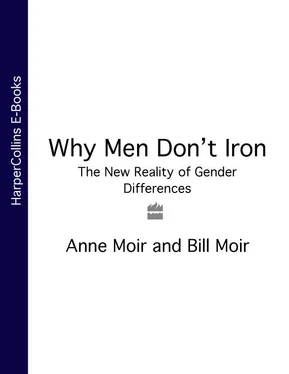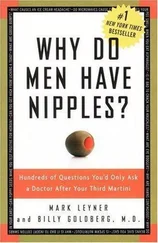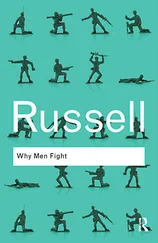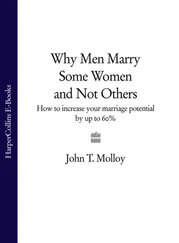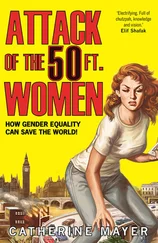It is insulting to the reader to qualify everything to death. This is a book about the biological science of gender differences, and science is about the probable. There is no need to keep saying this. So when we write ‘Science finds such and such’ it plainly means that this is the best bet: no more, no less. Similarly, a word like ‘men’ is used as a general term for most men – men in general. In the use of such a general term there will plainly be exceptions. Thus, when we write: ‘Men run 8% faster than women’, we leave it to the fourth-rate mind to point out that some women run faster then most men.
Our aim is to explain, not to campaign.
Today’s man is under pressure to change. He is told to get in touch with his feelings, to be more considerate, to be more communicative and open to his emotions. Yet this new, softer, more caring male, just like the old-fashioned patriarchal man, is a one-dimensional caricature of what it is to be masculine. It is a form of sexism, a masculine stereotype as extreme and as crudely reductionist as its predecessor, the traditional male.
The traditional male is a dominating bully, a misogynist who stamps his views on women. He believes the female is merely a pale and inferior copy of himself, an adumbration of the superior male. This male sets the standard: he is normal, she is deficient. He sees only one side, his.
Any man who matches this stereotype is indefensible, for he reduces women to an inferior status by denying her essential and valuable feminine qualities. But equally, those with a gender agenda deny the essential male qualities.
The new, caring male has recognized his shortcomings and corrected them. He sees that the old sex boundaries had nothing to do with biology, but were the results of social pressures (perhaps he was given toy guns instead of dolls). This is the male who has got in touch with his ‘female side’, and the defining quality of his masculinity has become the denial of his masculinity. She is the new standard, and he can only aspire to be more like her.
The reader may find one or both of these views a farrago of nonsense. But both viewpoints, if only because they are widespread, must be taken seriously. Each highlights a set of social aspirations and both lead to false expectations. Past and present views of the male – traditional and postmodern – are equally poor measures of the masculine.
The traditional male is well known; the postmodern version is less so (at least outside the academic world). The ‘new’ man is predicated on the understanding that all significant differences in gender are socially conditioned, constructed or learned. This is crucial. A man is not born a man, but is made into one by the assumptions of the culture in which he grows up. Take away the assumptions and he would grow up – what? A woman? There is an ambivalence here, but we need to recognize that there is a ritual obeisance in postmodern studies to all things complex and ambivalent. Postmodernism is a rejection of hitherto accepted certainties. Uncertainties are therefore good. The ambiguous is good, the clear-cut is bad. Seeing things as good or bad is also bad; right or wrong is wrong, and clarity is out.
When ambiguity becomes the answer then the clear distinctions between male and female disappear. Differences are there to be ironed out. Conventional gender boundaries are there to be erased. The war between the sexes can be ended by the realization that there are no sexes (‘we are all the same’). This belief rests on the perception that gender differences are a social construct (on the same grounds, this perception might appear no more than a social construct of the academy). The dispersal of our identities offers the hope of social and sexual reconciliation and thus an end to confrontation.
‘Do the postmodern academics really believe all that?’ asks Anne.
‘Worse,’ says Bill.
Postmodernists assert that all knowledge is constructed. Therefore there is no scientific truth or facts; only several versions of ‘facts’, constructed out of every individual’s cultural conditions. No one person’s version of the ‘facts’ can take precedence over any other’s. However, they often go on to say that, in the interests of ‘diversity’, the version of the ‘facts’ held by minority groups is to be given precedence. Somehow, postmodern women consider themselves a minority group.
‘No scientific truths –?’ asks Anne.
‘Maybe they give equal weight to the theory that the earth is flat,’ suggests Bill.
In an article entitled ‘How Feminism is Now Alienating Women from Science’, Noretta Koertge says: ‘Feminists add a new twist to this old litany of repudiations of analytical reasoning by claiming that the standard norms and methods of scientific inquiring are sexist because they are incompatible with women’s ways of knowing.’ 6These ‘subjectivist’ women see the methods of logic, analysis and abstraction as ‘alien territory belonging to men’ and they ‘value intuition as a safer and more fruitful approach to truth’.
Paul Gross and Norman Levitt note in an abstract of their book Higher Superstition that: ‘if they [the recruits to the cause of feminist science] attempt to hold fast to the most emphatic tenets of feminist dogma – for instance, the stylish assertion that “women” can’t be “scientists” under the present order, because society constructs these as mutually exclusive categories, and therefore that scientific practice must be reconstituted along radical-feminist lines before women can participate – they will quickly find themselves effectively excluded from serious scientific work.’ 7
Listen to Rosi Braidotti, Professor of Women’s Studies at the University of Utrecht, describe her postmodern version of science:
It is because of this dynamic, life-giving element that I have chosen the term nomadic to describe this feminist style. Nomadic subjects are capable of freeing the activity of thinking from the hold of phallocentric dogmatism, returning thought to its freedom, its liveliness, its beauty. There is a strong aesthetic dimension in the quest for alternative nomadic figurations and feminist theory such as I practice that is informed by this joyful nomadic force … I think it is extremely important for feminists to break away from the patterns of masculine identification that high theory demands, to step out of the paralyzing structures of an exclusive [read, ‘scientific’] academic style. 8
The shift is from the modern to the postmodern world: to a world without graven rules or certitudes (except for the law against laws). The overriding cliché is that there is as much variance within a sex as exists between the sexes. The postmodern, deconstructed intellectual cannot say simply, ‘Women are like this’ or ‘Men are like that’, because such statements acknowledge a biological difference; there can be no such difference if sexual identities are constructed and, consequently, capable of being deconstructed. This view, which became popular in the 1980s, was labelled ‘deconstructive feminism’. ‘This form of academic feminist thinking,’ wrote Lynne Segal, a feminist theoretician, ‘was increasingly sceptical of any generalisations about “women” or women’s “distinctive perspective”. Some feminist theoreticians were now questioning all types of fixed categories, identities and relationships, stressing what they saw as the complex, shifting and plural nature of the social meanings.’ 9
Plainly the traditional male, the deeply unreconstructed brute himself, is a sad anachronism in this shifting, boundary-free world, and so the attempt is being made to change him. This can only be done, of course, if we accept that masculinity is a social, cultural, political or historical construct in the first place. At Hobart College in New York State there is a men’s study programme, Course 245: Men and Masculinity, and the course summary offers the underlying assumption that ‘masculinity is problematic – for men and for women – but also socially conditioned and historically variable, and therefore subject to change.’ 10‘Male and female created he them’, but the academy is at hand to undo the damage. The academy holds to a common subtheme that the world was first constructed by men and the female’s role in the world was also made by him; that being the case, women can now return the compliment by reconstructing the world and his role. Call it revenge, if you like, but there is a conscious attempt to undermine masculine identity.
Читать дальше
